A
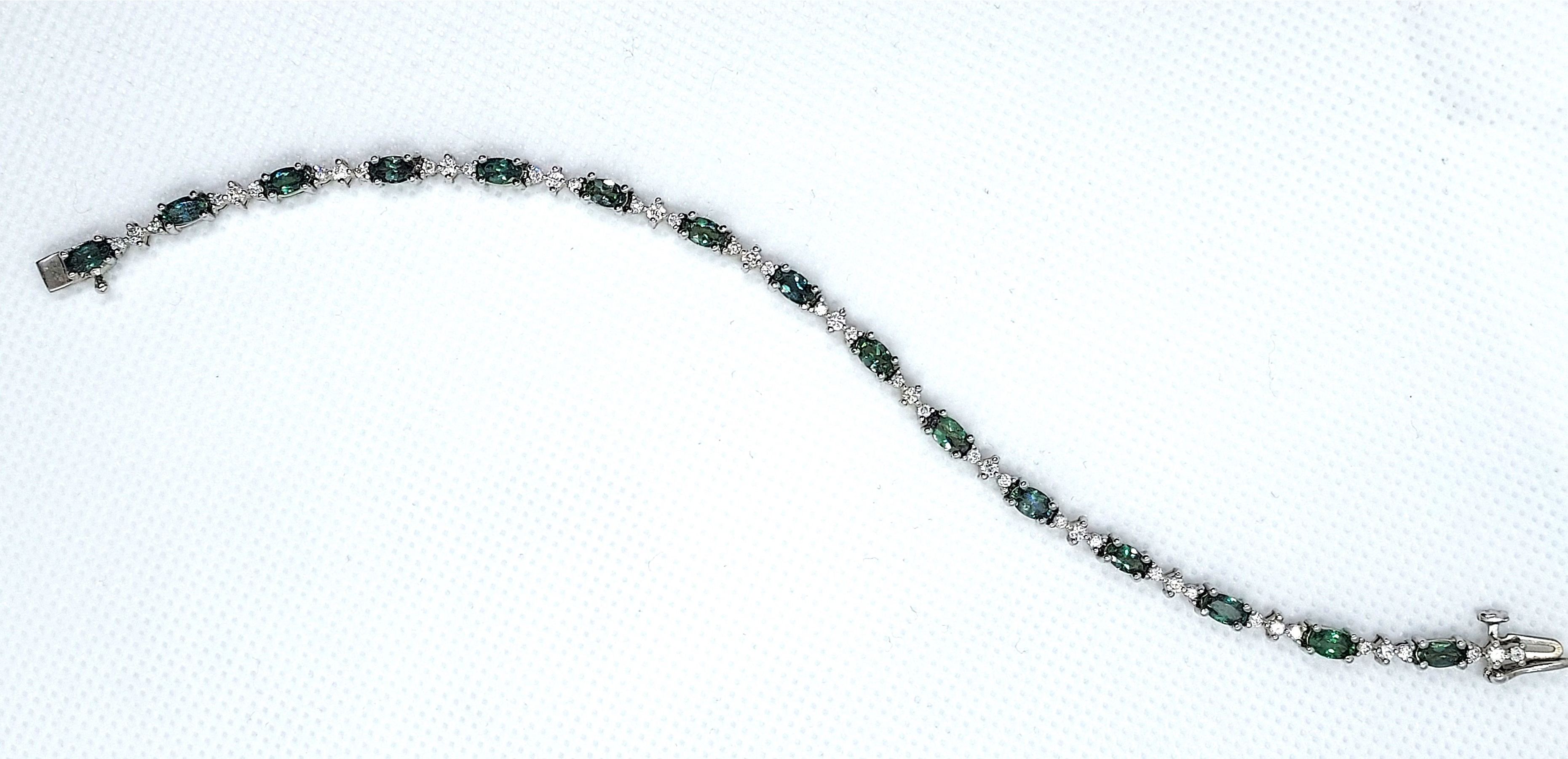
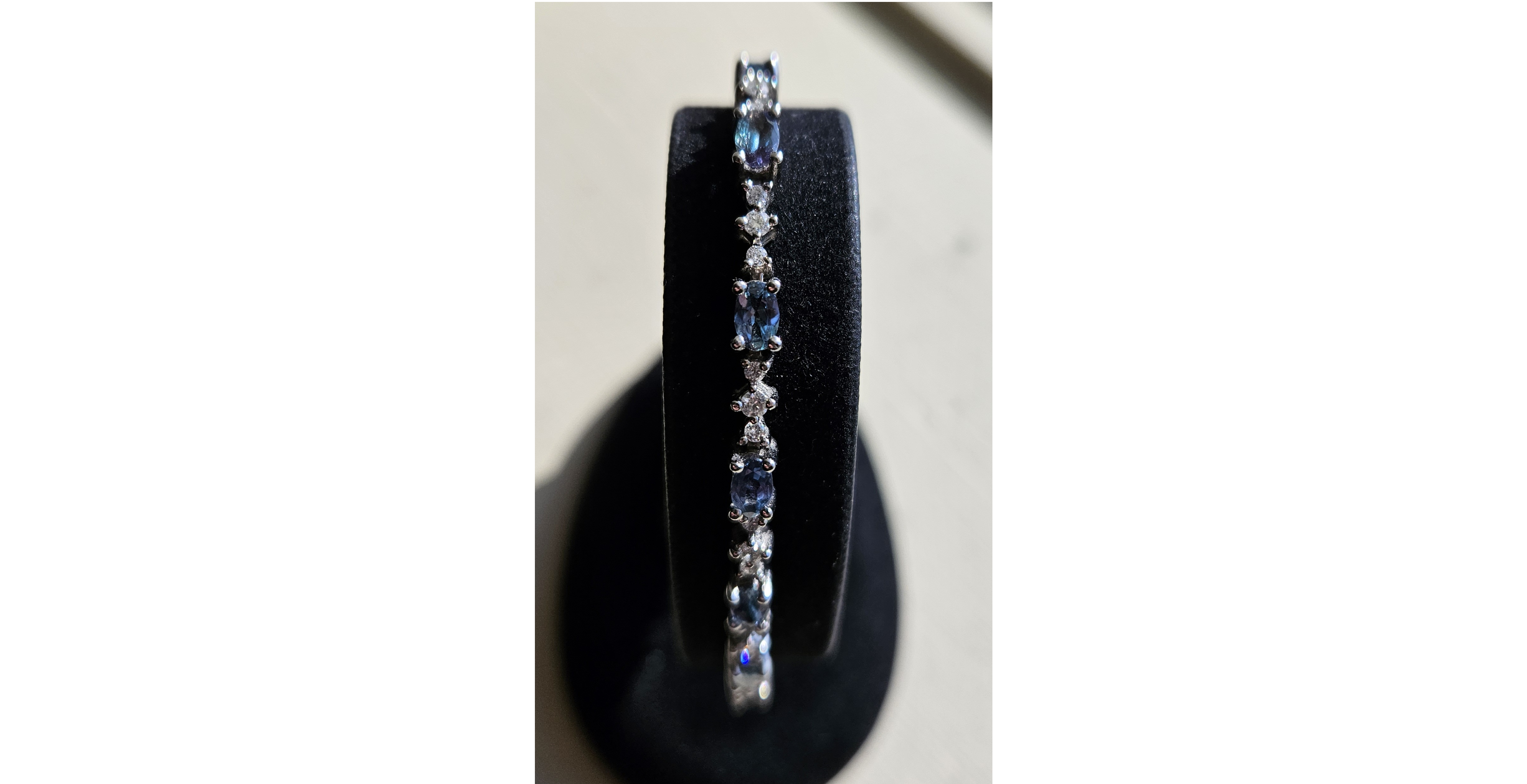
ALEXANDRITE
Name: It was named after Czar Alexander II of Russia when it was discovered in the Ural Mountains on his birthday in 1830.
Description: a rare chrysoberyl variety with chameleon-like qualities; a lovely green in daylight or fluorescent light changing to brownish or purplish red in incandescent light.
Variety: Chrysoberyl; color-change.
Color: Often described as emerald by day and ruby by night.
Daylight/Fluorescent Light: green to bluish-green or teal.
Incandescent Light/Candlelight: red to purplish-red, raspberry red, purplish-mauve, or brownish.
Composition: BeAI2O4 with trace amounts of chromium giving it its color.
Treatments: Typically untreated to preserve its inherent color-change value.
Moh’s Hardness: 8.5
Toughness: Excellent
Location Found: East Africa; Brazil; Madagascar; Russia (Ural Mountains); Sri Lanka (Ceylon); Tanzania; Zimbabwe.
Birthstone: June.
Wedding Anniversaries: 45th, 55th.
Zodiac Signs: Aquarius; Gemini; Scorpio.
Chakra Associations: Heart.
Historical Associations: good fortune; prosperity; luck; balance; transformation; change; chameleon; balance between physical and spiritual worlds; intuition strengthened; psychic awareness strengthened; self-esteem; emotional balance; Mercury; Uranus.
Historically Used to Treat: blood purification; strengthen blood vessels; circulatory system; spleen; pancreas; nerve regeneration; restore vital energy/life force.
Care: Stable to light, heat, and chemicals. Ultrasonic and steam cleaning are usually safe, but caution is advised if the stone has internal fractures or fracture-filling. Warm, soapy water and a soft brush are safe to use.
Imitations: Synthetic color-change sapphire/corundum; Synthetic color-change spinel.
Synthetics: Flux Growth; Czochralski; Floating Zone.





AMBER
Name: from the Arabic word “anbar,” meaning “fragrant substance”. This term was originally used for “ambergris”, a waxy substance used in perfumery. When true amber (fossilized resin) was introduced to the middle East, its fragrance when burned led to the name being transferred. The ancient Greeks called it “electron,” from which the word “electricity” is derived, due to its ability to generate a static charge when rubbed.
Description: An organic gemstone, Fossilized Tree Resin (C10H16O), primarily from an extinct species of coniferous tree (most commonly from the Baltic region). It is an amorphous material, not a crystalline mineral. It is very light, often floating in saltwater.
Color: It has a color range from whites, yellow, oranges to reds and browns, and blue.
Ranges from pale yellow and honey-golden (mot common) to deep orange, reddish-brown (cherry), green, and blue (most famously from the Dominican Republic). Opaque or cloudy varieties, often called “bone amber”, contain numerous microscopic air bubbles.
Treatments:
Heating (lightens color; stable; occasional; undetectable). Heating in oil (clarifies cloudy amber and sometimes produces sun spangles; stable; common/occasional; may be detectable).
Dying (darkens color; may fade; occasional; may be detectable).
Clarification: heating amber in oil or nitrogen to remove cloudiness and improve transparency.
Color Modification: Heating can deepen the color to red (called “cherry amber”).
Sun Spangles: heating creates small, disc-like fractures that reflect light, an effect sometimes desired.
Reconstruction (Ambroid/Pressed Amber): smaller pieces of natural amber are heated and compressed together to form a larger, single piece.
Moh’s Hardness: 2 to 2.5
Toughness: poor.
Location Found: Baltic Coast/Region; Germany; Latvia; Lithuania; Poland; Russia-Kaliningrad; Dominican Republic; Mexico (Chiapas); Myanmar (Burma.
Birthstone: November.
Wedding Anniversaries: 10th.
Zodiac Signs: Aquarius, Leo, Sagittarius, Taurus.
Chakra Associations: Solar Plexus; Sacral.
Historical Associations: beauty; warmth; courage; protection; personal power; will; creativity; emotion; life force; Sun; Mars; life-giving energy; healing; soul of the tiger; electrostatic properties; protection from bad luck; renewal; purification; clarity; balance emotions; clear the mind; intellect stimulated; enhance creative expression; absorbs negative energy and convert it into positive energy.
Historically Used to Treat: disease; madness; teething pain; illness; fevers; colds; asthma; rheumatism; heart; heart issues; thyroid; thyroid issues; digestive issues; stress.
Care: Avoid high heat. Avoid all ultrasonic, steam, and chemical cleaners. Chemicals that should be avoided are acids, caustics, alcohol, and gasoline. Burns at low temperatures. Light may darken it with age. Luke warm, soapy water and a very soft cloth are safe. Do not store with harder jewelry, it can scratch it easily.
Imitations: Ambroid (reconstructed or pressed amber); Copal (a natural resin, younger than amber); Plastic (Bakelite, cellulose nitrate, or modern resins); Yellow-colored Glass.
Synthetics: N/A.
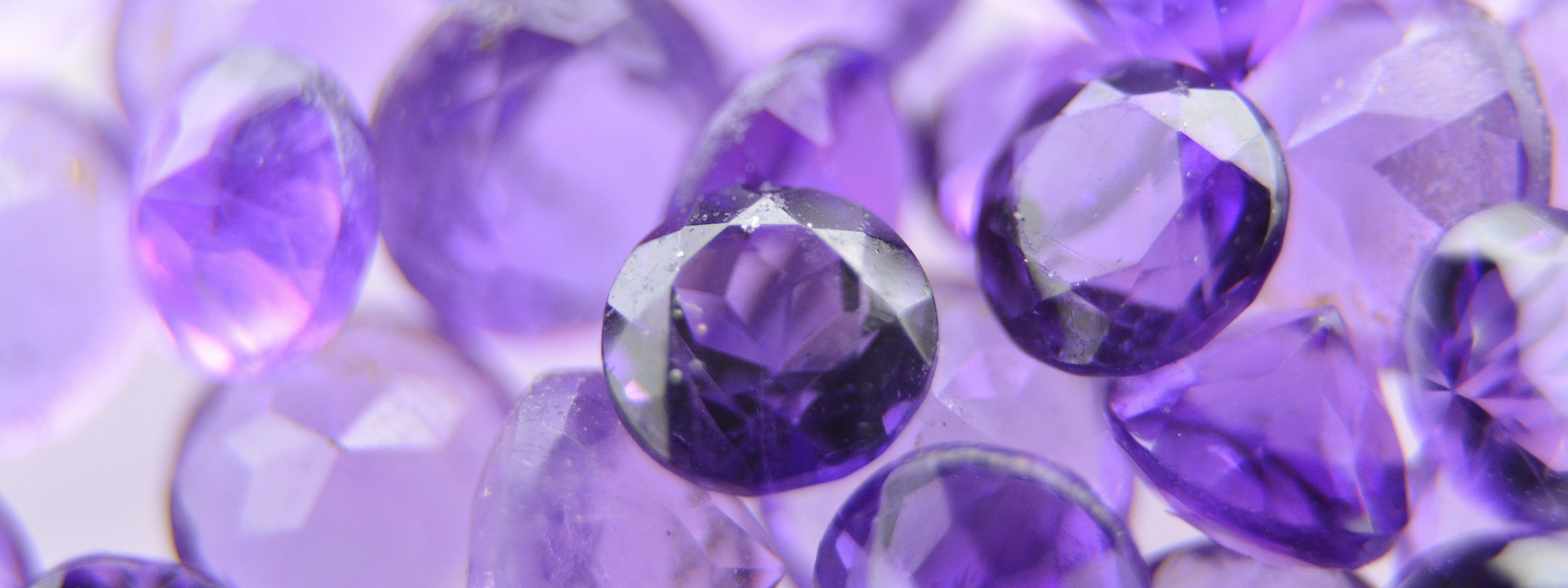
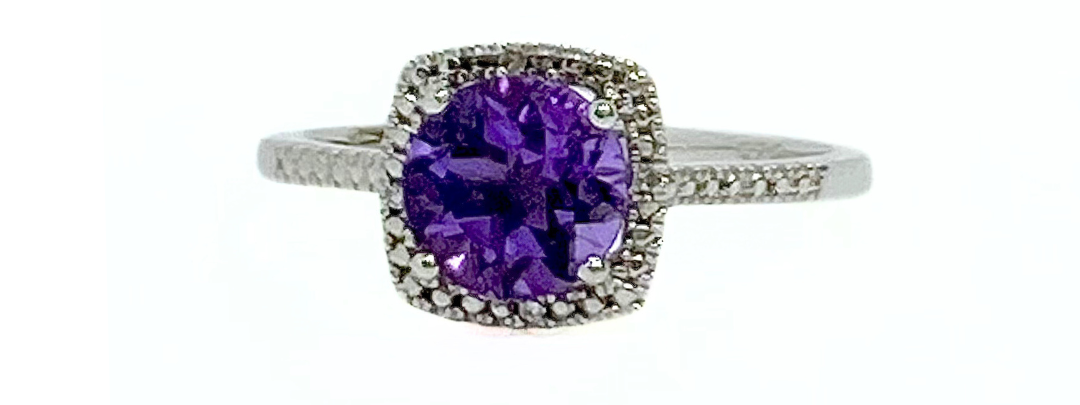
AMETHYST
Name: Amethyst comes from the Greek word “amethystos” meaning “not drunken” or “not intoxicating”. It was adopted into Latin as “amethystus” and Old French as “ametiste”.
Color: Amethyst is the purple to violet hued variety of Quartz. It gets its color from iron and manganese and has a color range from purple to violet and pale lilac to deep purple or grape hue. Today, the most sought-after color of Amethyst is a deep purple with high saturation.
Quality:
AA: Light to medium purple.
AAA: Medium dark purple to reddish purple.
Treatments:
Heat lightens color or produces citrine or green quartz. Stability is excellent. Occasional. Undetectable.
Foil backing improves color. Not permanent. Rare. May be detectable.
Moh’s Hardness: 7.
Toughness: good.
Location Found: Russia, Brazil, Africa, Siberia, Germany, Italy, Uruguay, Zambia, South Korea, South America, Bolivia, Canada, and the United States of America.
Birthstone: February (1912, National Jeweler's Association; Jewish; Polish; Roman).
Wedding Anniversaries: 6th, 33rd, and 48th.
Zodiac Signs: Aquarius, Pisces, and Capricorn.
Chakra Associations: Crown, Third-Eye.
Historical Associations: love; spirituality; sincerity; quick wits; clear-headed; good luck during wars or hunts; to ward off evil spirits; banish sorrow; avert everyday perils; dispel negative energy; bring material wealth; royalty; empower one with alacrity and acumen; intuition; psychism; happiness; calmness.
Historically Used To Treat: wounds (help heal); get rid of poisons in the body; sorrow; drunkenness; intoxication; headaches; insomnia.
Care: Ultrasonic cleaners are safe unless the gemstone has been treated with dye or has been fracture-filled. Avoid steam cleaning. Abrupt temperature changes can cause it to fracture. Its color can fade with prolonged exposure to intense light. Amethyst does not react with most acids or chemicals; however it can be etched by hydrofluoric acid and damaged by ammonium fluoride and alkaline solutions. Commercially available jewelry cleaners are safe. Warm, soapy water and a soft cloth is safe. Rise with warm water and dry with a soft clean cloth.
Imitations: Glass; Purple synthetic corundum; Assembled stone (synthetic spinel triplet).
Synthetics: Hydrothermal.
AMETRINE
Name: The name is a portmanteau (a blend) of the two quartz varieties it contains: Amethyst (the purple part) and Citrine (the yellow/orange part). Its trade name, Bolivianite, comes from its primary source.
AKA: Bolivianite.
Description: a bi-color variety of quartz that is a natural mixture of amethyst and citrine within in a single gemstone.
Ametrine is a natural bi-color variety of Quartz (SiO2). The coloration is due to traces of iron in different oxidation states, occurring due to a temperature gradient during the crystal's formation.
Variety/Species: quartz
Color: Distinct zones of Purple (or violet-purple) and Yellow-Orange (or golden-yellow to golden-brown). The most desirable stones feature an abrupt and clear 50/50 split of color.
Treatments:
Heat Treatment is common to enhance the color contrast between the purple and yellow zones or to improve color saturation.
Irradiation, often followed by heat, can also be used to deepen the colors.
Note: Naturally occurring Ametrine is rare; much of the material sold may be heat-treated Amethyst or synthetic.
Moh’s Hardness: 7.
Toughness: good.
Location Found: Anahi Mine in Bolivia (aka: Bolivianite)(only significant commercial source of natural Ametrine); Brazil; India.
Birthstone: February, November.
Wedding Anniversaries: 6th, 13th.
Zodiac Signs: Libra; Pisces; Sagittarius.
Chakra Associations: Solar Plexus, Third Eye, Crown.
Historical Associations: action; confidence; power; spiritual connection; intuition; wisdom; balance; clarity; integration; harmonize mind and spirit; spiritual guidance brought into physical action; mental clarity; focus; creativity; problem-solving; breaking bad habits; overcome prejudice.
Historically Used to Treat: balance the endocrine system; boost immune system; stress-related illnesses, chronic fatigue; depression; detoxification; allergies; digestive issues; stress; tension.
Care: Avoid prolonged direct sunlight as it can cause color fading (particularly to the purple/amethyst component). Avoid sudden temperature changes. Avoid hydrofluoric acid. Ultrasonic and steam cleaners are generally considered safe for non-fractured, natural Ametrine, but caution is still advised. Warm, soapy water and a soft cloth are safe.
Imitations: Colored glass; quartz doublets.
Synthetics: Synthetic Ametrine is created in laboratories, often by growing quartz crystals in a controlled environment and using irradiation and heat to create the color zones. It can sometimes be identified by unnaturally vivid colors or extremely sharp, perfect color boundaries (flame-fusion or hydrothermal types are possible).
ANGELITE
Name: The name “Angelite” is a trade name for the soft blue variety of anhydrite. The name for “anhydrite” comes from the Greek “anhudros (or anhydras)” meaning “without water”, referring to its chemical composition.
AKA: blue anhydrite.
Description: blue anhydrite; a soft blue stone.
Composition: CaSo4 (calcium sulfate)
Variety: anhydrite
Color: pale blue to deeper, glacier-blue, or lilac-blue. It often has a white center and/or snow-white flecks, sometimes reddish-brown or rusty inclusions.
Treatments:
Wax: used to enhance its soft luster.
Stabilized: with resin to improve durability due to its softness.
Moh’s Hardness: 3. To 3.5.
Location Found: Britain; Egypt; Germany; Libya; Mexico; Peru; Poland; United States (Colorado, New Mexico).
Birthstone: N/A
Wedding Anniversaries: N/A
Zodiac Signs: Aquarius. Aries. Gemini. Pisces.
Chakra Associations: Throat, Third Eye, Crown.
Historical Associations: communication; peace; celestial guidance; angels; angelic communication; angelic invocation; truth; tune into subtle frequencies; ancestor veneration; dreamwork; dream protection; divine channeling; spirit; tranquility; spiritual realms; awareness; connection with angelic realm and spirit guides.
Historically Used to Treat: anxiety; stress; supports throat; supports thyroid; arms; lungs; inflammation (body, field); grief; emotional expression; infections; water balance; tissue repair.
Care: Very sensitive to water; prolonged exposure or immersion will case it to absorb moisture and slowly revert to gypsum, changing its structure and appearance. Keep dry. Prolonged direct sunlight will cause color loss (fading). Never steam or ultrasonic clean. Clean only with a soft, dry cloth. Store in a dry, dark place.
Imitations: no known
Synthetics: no known produced for the jewelry market.

ANYOLITE
Name: Anyolite is derived from the Maasai word anyoli, which means "green." It was named after its discovery in Tanzania, where the Maasai people reside. It is the trade name for Ruby in Zoisite.
AKA: Ruby in Zoisite.
Description: Ruby in Zoisite. A captivating metamorphic rock composed of a natural combination of two major minerals: green Zoisite and opaque red Ruby (a variety of Corundum), often with black or dark green inclusions of Pargasite (a type of Hornblende).
Composition: Rock (not a single mineral). Composed of intergrown Zoisite (Ca2Al3(SiO4)3(OH)), Ruby (Al2O3), and Pargasite (or Hornblende).
Color: Vibrant Green (Zoisite), Opaque Red/Pink (Ruby), and Black/Dark Green (Pargasite/Hornblende).
Treatments: Not generally treated or enhanced.
Oiled/Polished: to improve surface luster.
Moh’s Hardness: varies as it is a rock composition: 6.5 to 7 for the zoisite and 9 for the ruby.
Location Found: India; Tanzania (Arusha Region); Zambia.
Birthstone: July.
Wedding Anniversaries: N/A.
Zodiac Signs: Aquarius; Aries; Cancer; Gemini; Leo; Sagittarius; Scorpio.
Chakra Associations: Root, Heart, Crown.
Historical Associations: vitality (physical); passionate growth; spiritual transformer; patience; healing; passion; courage; self-confidence; transmutation of negative energy into positive energy; emotional healing of grief and despair; understand death as a transformation
Historically Used to Treat: immune system; adrenal fatigue; heart disorders; blood circulation; racing heartbeat; reproductive system; fertility issues; severe illness recovery; chemotherapy recovery; physical vitality.
Care: Protect from hard knocks or blows. Avoid ultrasonic and steam cleaners. Warm, soapy water and a soft cloth are safe.
Imitations: No common simulant, as its unique natural color pattern is difficult to convincingly replicate with simple materials.
Synthetics: Genuine Anyolite (Ruby in Zoisite) is a natural combination rock and has not been successfully produced synthetically.
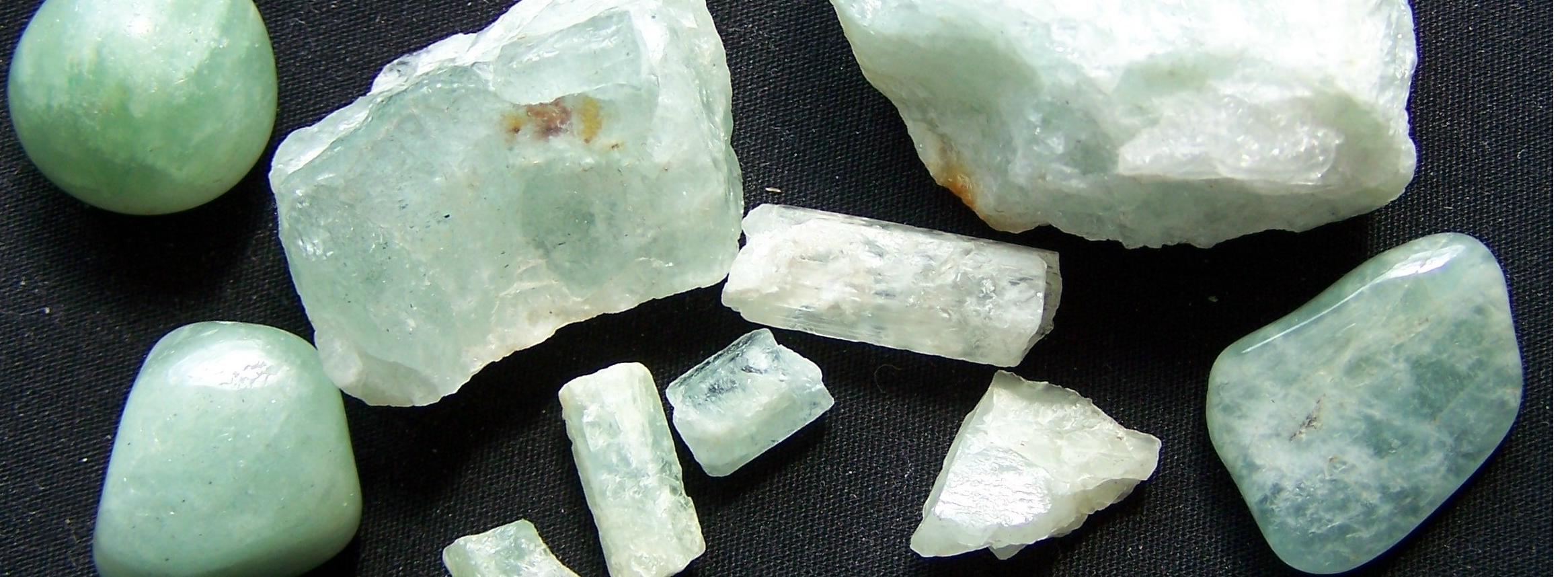

AQUAMARINE
Name: Aquamarine comes from the Latin word "aqua", meaning water, and "marina", meaning sea. It is also known as "water of the sea".
Color: Aquamarine is a beryl that gets its color from traces of iron and has a color range from blue to blue-green. Prior to the 1900s the preferred color for aquamarine was a light bluish-green. Today, the preferred color for aquamarine is blue.
Treatment: It is often heat-treated to remove the green, thus leaving a blue coloring that is permanent and stable.
Moh's Hardness: 7.5 to 8.
Location Found: Brazil, Pakistan, Afghanistan, Australia, Africa, Madagascar, Mozambique, Ukraine, Nigeria, Zamia, and the United States of America.
Birthstone: March (1912 the National Association of Jeweler's).
Wedding Anniversary: 16th, 19th.
Zodiac Signs: Pisces, Aries, and Gemini.
Chakra Associations: Throat.
Historical Associations: protect sailors; guarantee safe voyage by ship; happiness; joyfulness; fortunetelling; divination; help search for lost or hidden things; communication; clear thinking; healing; calmness; sympathy; harmony; trust; friendship; protection; soothing.
Historically Used To Treat: shortsightedness; eye strain.
Care: All aquamarine can be cleaned with warm soapy water. Ultrasonic and steam cleaners are safe to use as long as it is not fracture filled or has liquid inclusions. Aquamarine's color is stable with light exposure. Exposure to heat and hydrofluoric acid is not recommended.
AVENTURINE
Name: Derives from the Italian phrase "a ventura" or "per avventura," meaning "by chance" or "by accident." This refers to the lucky, accidental discovery of a similar-looking glass called Goldstone (or avventurino) by Venetian glassmakers in the 18th century. The name was later applied to the natural stone.
AKA: Yu Imperial Stone (ancient China; associated with the deity Guanyin Pusa)
Description: Aventurine Quartz (a variety of Quartz, SiO2), belonging to the Chalcedony mineral class. A variety of quartz characterized by a glittering effect called aventurescence; which is caused by small, platy inclusions of other minerals, most commonly green mica but can also be Fuchsite (green chromium-rich mica, giving green color) or Hematite/Goethite (giving red/brown/orange colors).
Variety: quartz
Color: green, blue, red, reddish-brown, orange, yellow, peach, gray, white.
Treatments: Generally not heavily treated.
Dyed: lower quality material is dyed to enhance color (usually green or blue).
Impregnated: with resins/oils to improve stability and polish.
Moh’s Hardness: 6.5 to 7.
Location Found: Austria; Brazil; China; India (esp. green, blue-green varieties); Russia (Urals); United States.
Birthstone: April 20 – May 20.
Wedding Anniversaries: N/A.
Zodiac Signs: Aries, Cancer, Gemini, Taurus, Virgo.
Chakra Associations: Throat (blue); Heart (green); Solar Plexus (yellow); Sacral (orange); Root (red).
Historical Associations: mercy; health; eyesight; warrior queen; opportunity; gambling; luck; prosperity; abundance; confidence; decisiveness; leadership qualities; balancing emotional body; fostering compassion; fostering empathy; perseverance in the face of change; optimism in the face of change.
Historically Used to Treat: eyesight; nearsightedness; prevent optic loss; soothe skin problems; acne; eczema; allergies; lungs; adrenals; physical heart; cardiovascular system; anger.
Care: Avoid sudden temperature changes, harsh chemicals, and prolonged exposure to direct sunlight; all of which may affect dyed material. Ultrasonic and steam cleaners can be used with caution. Warm, soapy water and a soft cloth are safe.
Imitations: Goldstone (or Aventurine Glass): A man-made glass with metallic copper flecks to mimic the glittery effect. Aventurine Feldspar (Sunstone) can be confused with orange/red aventurine quartz but is a different mineral.
Synthetics: Synthetic Quartz with controlled inclusions can be lab-grown, though true synthetic Aventurine is less common than the Goldstone imitation.
